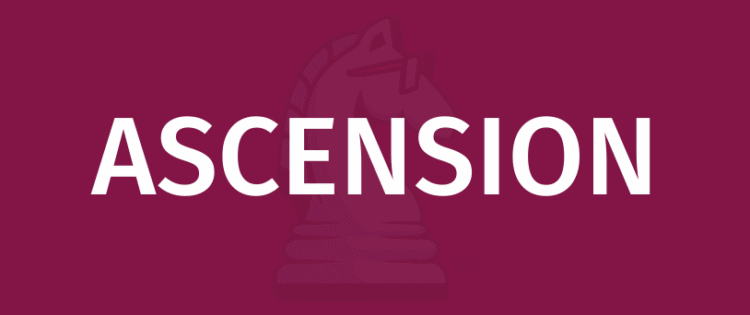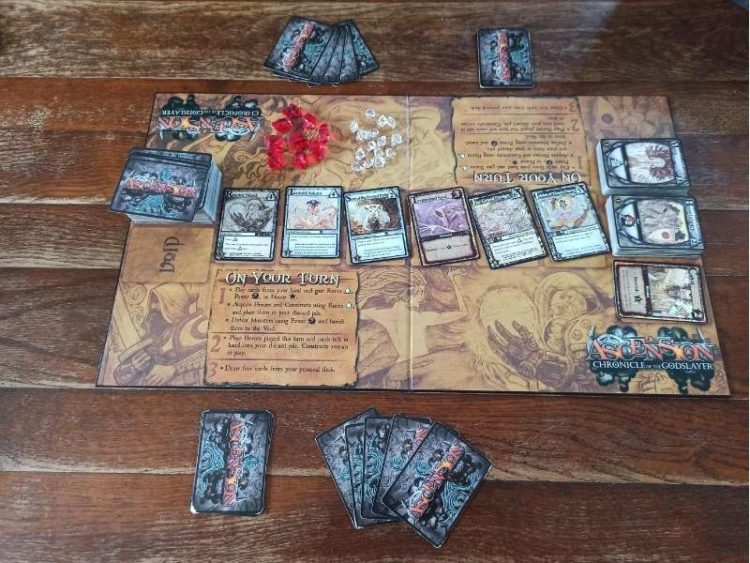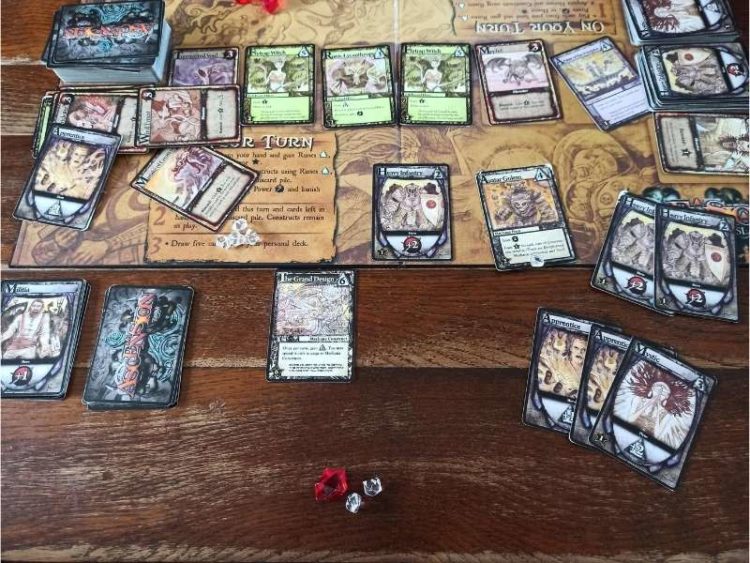
OBJECTIVE OF ASCENSION: The objective of Ascension is to collect as many honour points as possible by recruiting powerful heroes and facing fearsome monsters.
NUMBER OF PLAYERS: 2 to 4
MATERIALS:
- 1 game board
- 50 crystals (25 whites of value 1 and 25 reds of value 5)
- 200 cards
- 4 starter decks each consisting of 8 Apprentices and 2 Militias
- 60 base cards (1 Cultist, 30 Mystics, 29 Heavy infantry)
- 100 other cards forming the deck
TYPE OF GAME: Heroic deck building game
AUDIENCE: Teenagers, Adults
OVERVIEW OF ASCENSION
In Ascension: Chronicle of the Godslayer, you play as warlords fighting to unite the Vigil kingdom against evil forces. As you play the cards in your hand, you will gain runes, strength, and other effects to battle the monsters that threaten the Vigil kingdom. Runes are used to buy new cards, while strength is used to eliminate monsters, thus gaining honour and other benefits. The cards to be fought or acquired are constantly changing, forcing you to weigh your choices carefully at all times in order to save Vigil and earn the most honours.
SETUP
The game board shows how the cards are laid out:
- The base cards (Heavy Infantry, Mystic and Cultist) are all stacked on the side; these cards are always available for purchase (or fighting, in the case of the Cultist).
- The centre line of 6 cards, made up from the draw pile
- The draw pile, located on the opposite side, and underneath the discard pile, called “The Void”
The remaining space on the board can be used to store honour crystals. A total of crystals equivalent to 30 points per player is used.
Each player receives a starting deck of 10 cards (2 Militia and 8 Apprentices), shuffles it and draws 5 cards.

Example of a 2 player setup
GAMEPLAY
Game turn:
- 1. Playing cards from his hand, to gain runes, strength and honour.
- 2. Place all the cards just played, and the rest of his hand, in his discard pile.
- 3. Redo his hand by drawing 5 new cards from his deck.
Resources:
- Runes (represented by grey triangles) are the main currency of the game, and allow you to recruit heroes and acquire constructs. The number of runes needed to acquire a card is shown in the top right corner of the card.
- Strength (represented by red swords) is a second currency, used to fight monster cards, except that these are not kept in the decks, but sent immediately to The Void and exchanged for victory points and other bonuses. The number of strength points needed to defeat a monster is shown in the top right corner of its card.
- Honour corresponds to victory points. Heroes and constructs are worth a certain number of honour points indicated on the star symbol at the bottom left of their card, while defeated monsters grant a certain number of honour crystals taken from the stock built up at the beginning of the game.
Other important rules
Playing cards:
- Playing a card usually costs nothing, and you can play as many cards as you like during your turn.
- At any time, if your draw pile is empty and you need to draw or reveal a card from the top of your draw pile, shuffle your discard pile and form a new draw pile.
- Hero cards played during your turn are placed in front of you and stay there. They will be discarded at the end of your turn (if you have to shuffle your discard pile during your turn, the cards played during that turn are not shuffled with the discard pile). Purchased cards are placed directly into your discard pile.
- The resources produced by the played cards (strength and runes) are available until the end of your turn. You must therefore keep track of your remaining runes and strength as you battle monsters and buy cards.
- Constructs are permanent cards: once played, they remain in play and are not discarded at the end of your turn. They provide various advantages: recurring strength bonus / runes or various effects that can be activated under conditions (specified on the card).
Fighting a monster:
- When you have enough strength from the cards played during your turn, announce the monster you are facing, deduct its strength cost from your available strength, then place the monster in The Void and apply its Reward effect.
- The Cultist is a “monster” always available to be confronted. When you confront him, don’t put his card in the Void, leave it in place (it is considered that there is always another Cultist to take his place).
The centre line:
- When a card leaves the centre line (if bought or fought), replace it immediately with a card from the centre draw pile, face up, before resolving any other effects. Each time a player makes a decision, the centre line must contain 6 cards.
- If the draw pile is empty, shuffle The Void and form a new draw pile.
Banishment and destruction :
- Banning a card means sending that card into The Void.
- If you ban a card from your hand, it does not count as having been played, so you do not benefit from its effect. A banned card is also not discarded at the end of the turn, it remains in The Void.
- If you ban a card from the centre line, you also do not benefit from its effects (nor from its rewards, in the case of monsters).
- Destroying a card means putting it in the owner’s discard pile. Usually, this effect is activated against constructs put into play by an opponent.

Turn example: the bottom player starts by playing an Avatar Golem, which grants him two swords and one honour crystal (because he has The Grand Design in play). He then plays a Heavy Infantry, that’s two more swords, so he decides to defeat the Mistake of Creation, thus winning four more crystals and being allowed to ban a card from his discard pile and/or the centre line. He bans one Apprentice and a Wind Tyrant. With his three remaining cards in hand (two Apprentices and one Mystic) he buys two Heavy Infantries.
Factions and synergies
The Hero and Construct cards are divided into 4 factions, each with different tactical orientations:
- Void cards are based on strength and banishment of cards from the player’s hand or discard.
- Mechana cards are often constructs that combine and bring a lot of honour at the end of the game.
- Lifebound cards combine with each other to bring more runes and honour
- Enlightened cards allow you to draw more cards per turn and ban cards from the centre line.
END OF GAME
When the supply of honour crystals is exhausted, the round is over and the game ends.Players add the honour points from their deck cards (not forgetting the cards in their discard and hand) to their honour crystal points total. The player with the highest total wins the game.

The top player wins by 83 points to 66. He mostly used Void cards for the strength (to defeat monsters) and Lifebound cards for honour bonuses, hence his many honour crystals.
- Comprehensive Guide to the Board Game Go (weiqi, baduk) - January 23, 2024
- Are Creative Suites Changing Gaming - October 30, 2023
- How Classic Games Have Been Reimagined for Modern Audiences - October 5, 2023